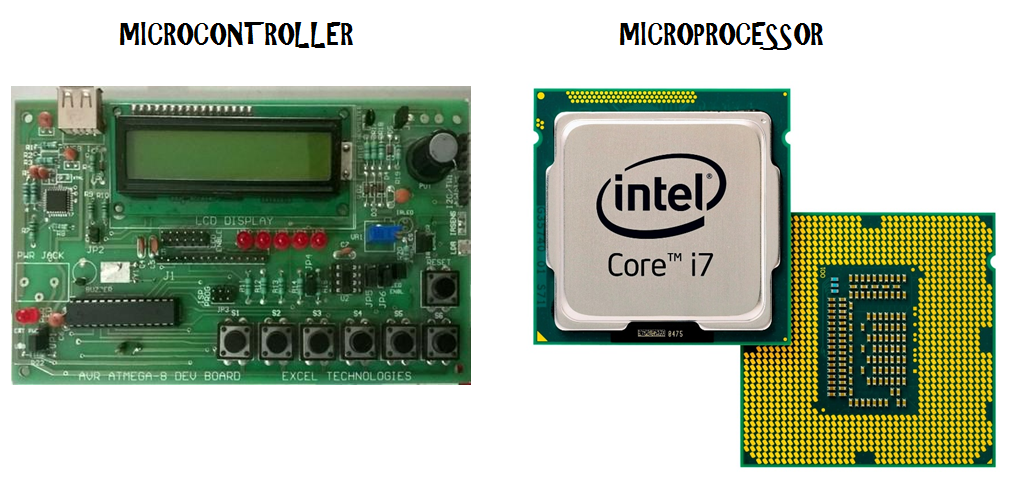微控制器,微处理器

The terms microcontroller and microprocessor are commonly misinterpreted to be the same thing even though they have wide areas of difference. The devices have real-time application in many fields. It is true that they share quite a number of similarities between them but the major differences can never be neglected. Apart from field experts, it is impossible for us to distinguish them just by their physical structure.
尽管微控制器和微处理器之间存在很大差异,但它们通常被误解为同一件事。 这些设备在许多领域都有实时应用。 的确,它们之间有很多相似之处,但主要区别永远不能忽略。 除了现场专家之外,我们不可能仅凭其物理结构来区分它们。
Microprocessors are the integrated chips which contain only the CPU inside them i.e. they perform only processing related operations and depend on other chips and systems for full functioning. You must have heard of Intel Pentium, Celeron, i3, i5 all these are microprocessors with only the processing unit. These ICs lack RAM, ROM, and other required peripherals or devices. So in order to obtain a complete system which can take input and generate output, these microprocessors must be coupled with other peripherals. These microprocessors find their uses in Desktops and Laptops.
微处理器是集成芯片,其中仅包含CPU,也就是说,它们仅执行与处理相关的操作,并且依赖于其他芯片和系统来发挥全部功能。 您可能已经听说过Intel Pentium,Celeron,i3,i5,所有这些都是只有处理单元的微处理器。 这些IC缺少RAM,ROM和其他必需的外围设备或设备。 因此,为了获得可以接受输入并产生输出的完整系统,这些微处理器必须与其他外围设备耦合。 这些微处理器可用于台式机和笔记本电脑。
On contrary to this microcontrollers have a designated CPU, RAM, ROM and other peripherals required for normal functioning all integrated within the chip, unlike microprocessors where extra peripherals are added externally. They have inbuilt input – output mechanism. Unlike microprocessors, these are used for performing only specific operations, thus they require a limited amount of resources such as RAM, ROM, I/O ports.
与此相反,微控制器具有指定功能的CPU,RAM,ROM和其他正常运行所需的外围设备,这些外围设备全部集成在芯片中,这与微处理器在外部添加额外外围设备的情况不同。 他们具有内置的输入-输出机制。 与微处理器不同,它们仅用于执行特定操作,因此它们需要有限数量的资源,例如RAM,ROM,I / O端口。
Microprocessors are incorporated in systems which needs to perform a wide range of tasks such as software development, graphics editing, browsing etc. Thus the type of input and the type of output required is not specified. Hence they require a high amount of RAM, ROM and I/O ports for proper functioning.
微处理器集成在需要执行各种任务(例如软件开发,图形编辑,浏览等)的系统中。因此,未指定所需的输入类型和输出类型。 因此,它们需要大量的RAM,ROM和I / O端口才能正常运行。
The operating frequency or the clock speed of microprocessors are kept high due to large workload they demand more speed and performance. On the other hand, microcontrollers require low oscillatory frequency because they are required to be energy efficient and cost-effective. The acting processing speed of microcontrollers is measured in MHz which ranges from 30-50 MHz whereas microprocessors speed is calculated in GHz ( gigahertz), for a typical desktop computer nowadays it is 3.22GHz.
由于工作量大,微处理器的工作频率或时钟速度保持较高,因此它们需要更高的速度和性能。 另一方面,微控制器要求低振荡频率,因为它们需要节能且具有成本效益。 微控制器的有效处理速度以MHz为单位测量,范围为30-50 MHz,而微处理器的速度以GHz(千兆赫兹)计算,对于当今的典型台式计算机而言,该速度为3.22 GHz。
In terms of cost, it is not a justifiable comparison since microcontrollers are used in small-scale devices which perform only specific operations, they obviously are far cheaper than microprocessors. However, no one can replace each other’s position in terms of operation. For example, a microcontroller will be too feeble to process the operations done by a microprocessor and if a microprocessor is used in place of a microcontroller then it will make the device too costly for its operation since they will require extra peripherals to work with them. So it is not advisable to use a microprocessor in microcontroller applications.
就成本而言,这不是合理的比较,因为微控制器用于仅执行特定操作的小型设备中,显然比微处理器便宜得多。 但是,在操作上,没有人可以取代彼此的位置。 例如,微控制器太微弱,无法处理微处理器完成的操作,如果使用微处理器代替微控制器,则将使该设备的操作成本太高,因为它们将需要额外的外围设备来工作。 因此,不建议在微控制器应用中使用微处理器。
微处理器的缺点 (Disadvantages of Microprocessor)
The size of the board is large compared to microcontroller since there is a large number of discrete components.
与微控制器相比,电路板的尺寸很大,因为存在大量的分立组件。
It requires different peripherals for different projects thus datasheet every component needs to be studied.
对于不同的项目,它需要不同的外围设备,因此需要研究每个组件的数据表。
单片机的缺点 (Disadvantages of Microcontroller)
Since all the components are present onboard, therefore, there is no scope for performance improvement by upgrading the components.
由于所有组件都在船上,因此,通过升级组件来提高性能没有任何余地。
微处理器的优势 (Advantages of Microprocessors)
The same microprocessor board can be utilized for different projects just by changing the peripherals required. Thus saving time and cost of interfacing the peripherals with the board.
只需更改所需的外围设备,即可将同一微处理器板用于不同的项目。 这样可以节省时间和将外围设备与电路板连接的成本。
微控制器的优势 (Advantages of Microcontrollers)
The cost of the microcontroller is far cheaper than microprocessor even for low power frequency. This makes them perfect for programming for low scale projects and devices. They are extremely portable thus helping in their easy mass production.
即使对于低功率频率,微控制器的成本也比微处理器便宜得多。 这使它们非常适合用于小规模项目和设备的编程。 它们非常便于携带,因此易于批量生产。
翻译自: https://www.includehelp.com/embedded-system/microcontrollers-vs-microprocessors.aspx
微控制器,微处理器




 微控制器和微处理器虽然常被误解为同一种设备,但它们有显著差异。微处理器只包含CPU,需要额外的外围设备,常用于台式机和笔记本;而微控制器将CPU、RAM、ROM和外围设备集成在单一芯片上,适用于特定操作,成本低,常用于小型设备。微处理器需求高性能,频率高,而微控制器追求能效,频率低。
微控制器和微处理器虽然常被误解为同一种设备,但它们有显著差异。微处理器只包含CPU,需要额外的外围设备,常用于台式机和笔记本;而微控制器将CPU、RAM、ROM和外围设备集成在单一芯片上,适用于特定操作,成本低,常用于小型设备。微处理器需求高性能,频率高,而微控制器追求能效,频率低。

















 被折叠的 条评论
为什么被折叠?
被折叠的 条评论
为什么被折叠?








